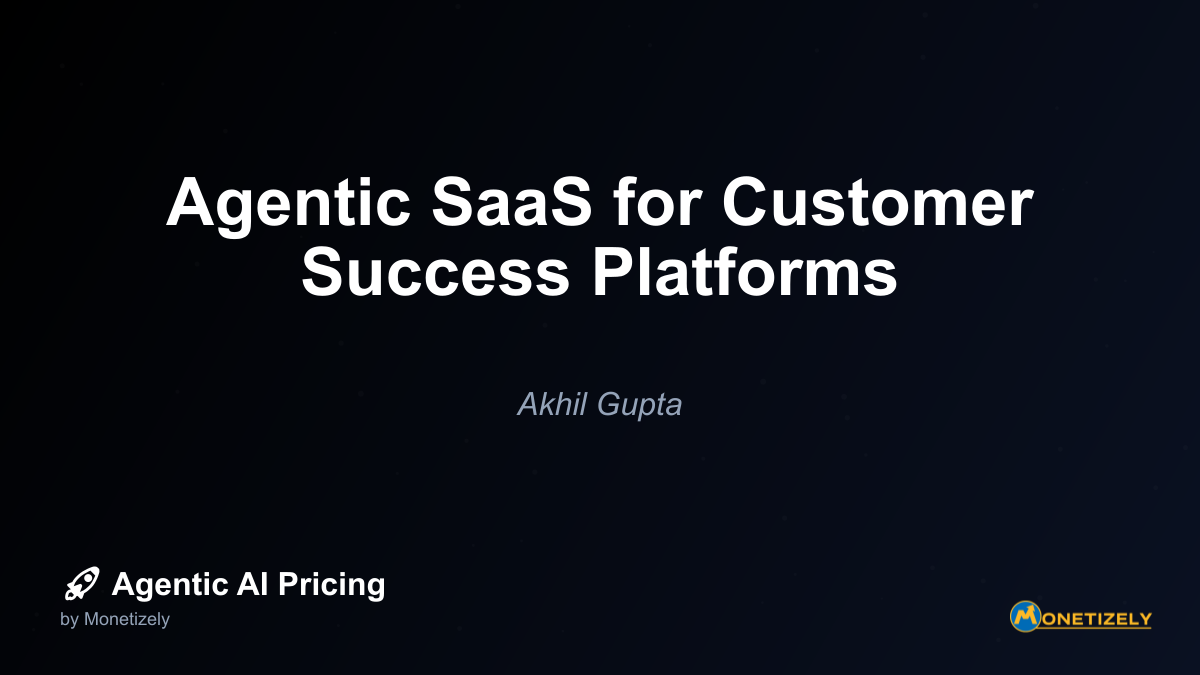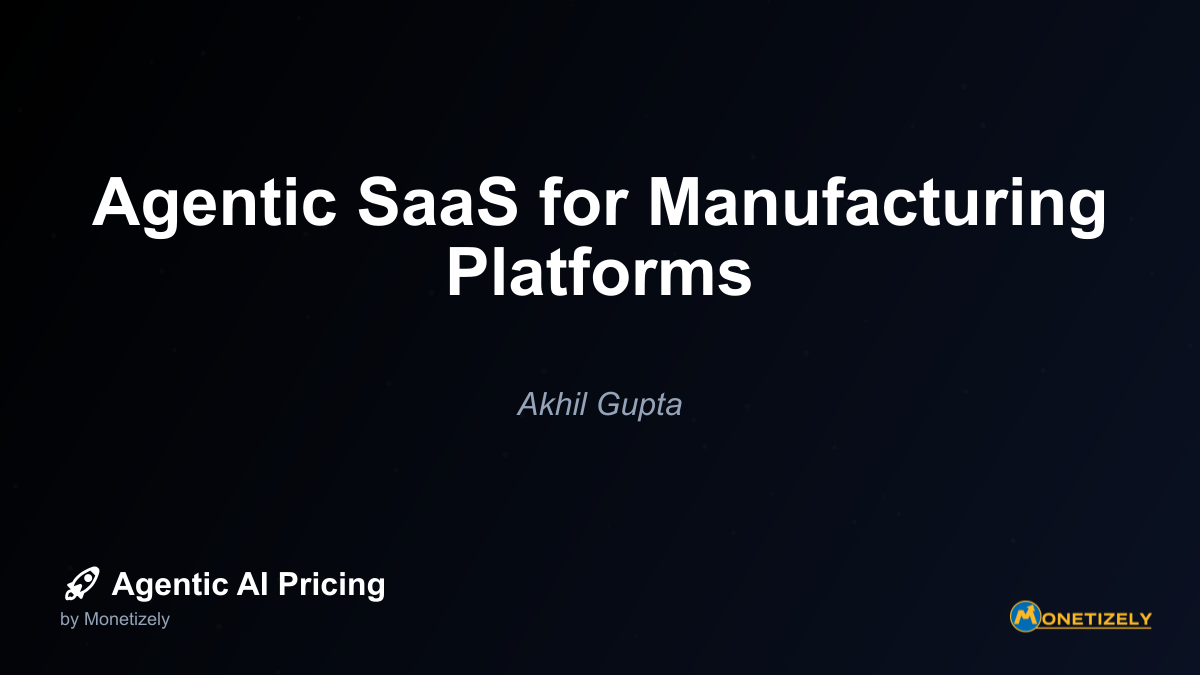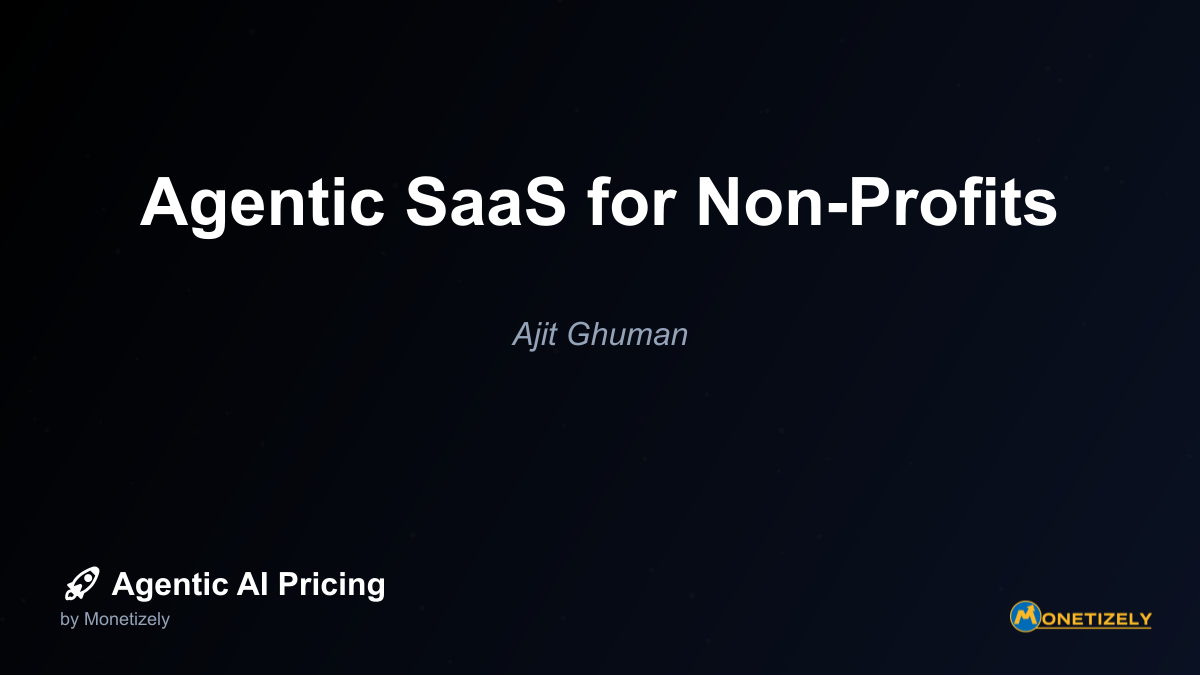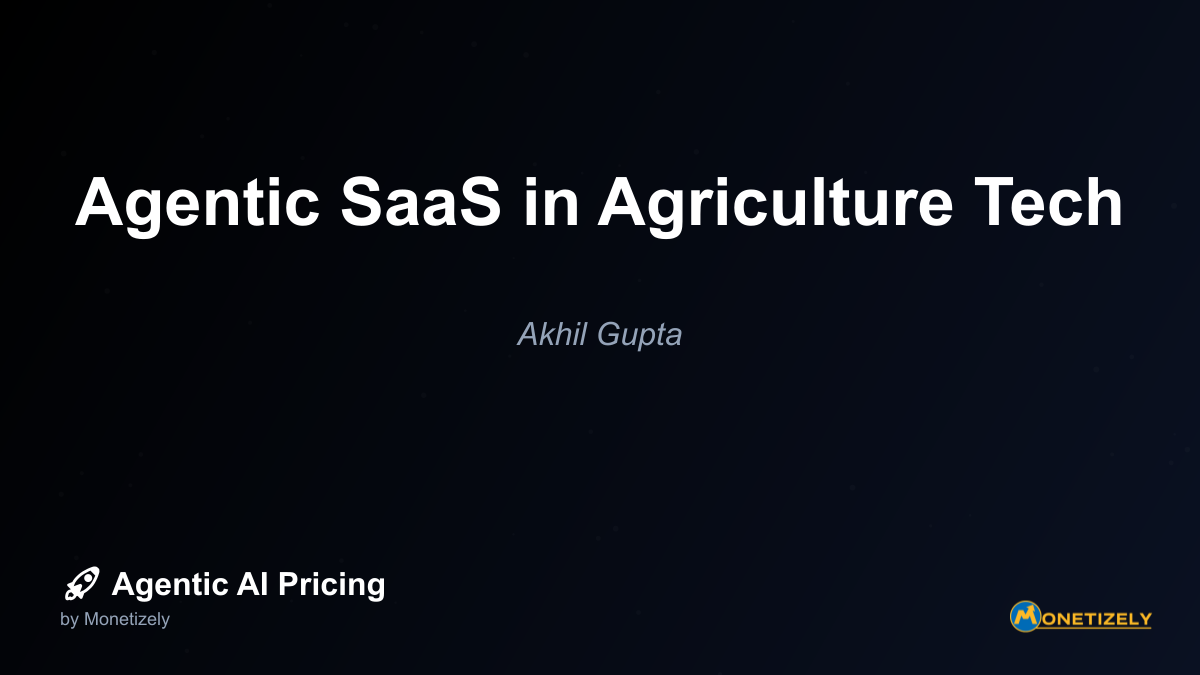· Ajit Ghuman · Vertical Applications · 12 min read
Agentic SaaS for Insurance Platforms
AI and SaaS Pricing Masterclass
Learn the art of strategic pricing directly from industry experts. Our comprehensive course provides frameworks and methodologies for optimizing your pricing strategy in the evolving AI landscape. Earn a professional certification that can be imported directly to your LinkedIn profile.
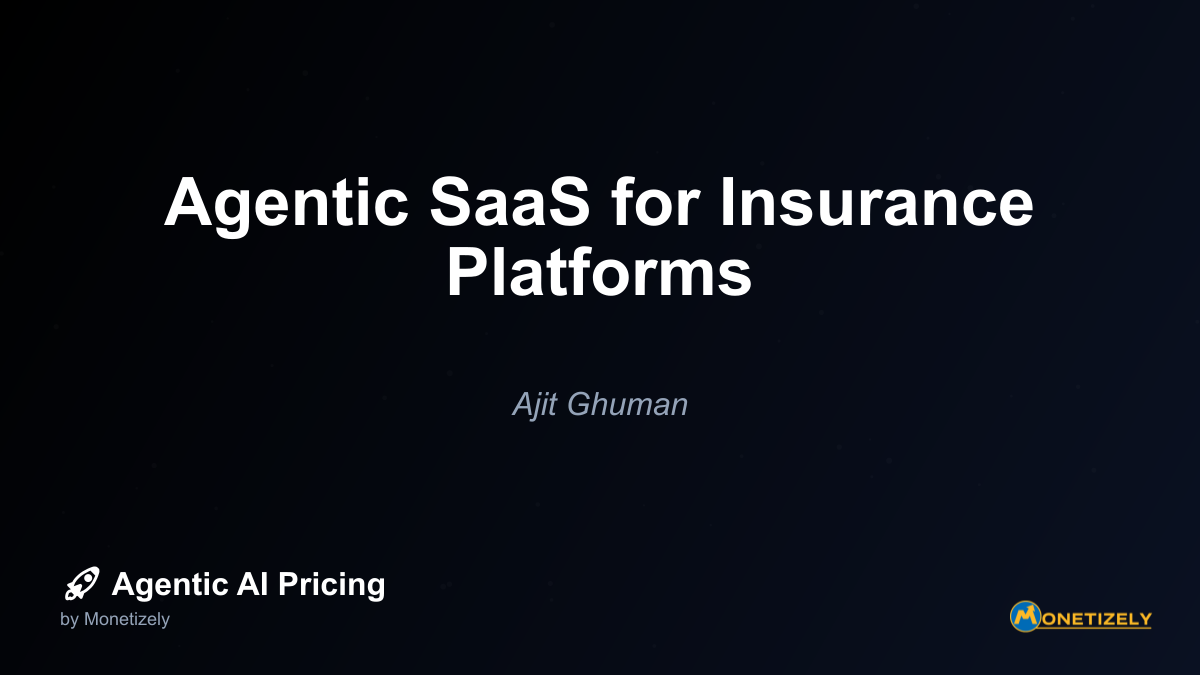
In the rapidly evolving landscape of insurance technology, agentic AI is revolutionizing claims processing through autonomous agents that streamline operations, enhance accuracy, and deliver superior customer experiences. This transformation represents a paradigm shift from traditional manual processing to intelligent, self-directed systems capable of handling complex insurance workflows with minimal human intervention.
The Evolution of Insurance Claims Processing
Insurance claims processing has traditionally been labor-intensive, time-consuming, and prone to errors. The typical claims journey involves multiple touchpoints, manual document reviews, and lengthy decision-making processes that frustrate customers and burden insurers with operational inefficiencies. This conventional approach faces several critical challenges:
- Lengthy processing times spanning days or weeks
- Inconsistent decision-making across similar claims
- High operational costs due to manual intervention
- Limited scalability during peak claim periods
- Customer dissatisfaction from delays and opaque processes
- Vulnerability to human error and potential fraud
The introduction of agentic AI—AI systems capable of autonomous decision-making and goal-oriented actions—marks a fundamental shift in this paradigm. Unlike traditional automation that follows rigid rules, agentic AI can understand context, learn from exceptions, and make intelligent decisions that mimic experienced human adjusters.
Understanding Agentic AI in Insurance Claims
Agentic AI refers to artificial intelligence systems that operate with autonomy, pursuing specific goals while adapting to changing circumstances. In insurance claims processing, these systems function as digital workers capable of handling end-to-end workflows with minimal human oversight.
Key Capabilities of Agentic Claims Processing Agents
Modern agentic AI systems for insurance claims demonstrate several distinguishing capabilities:
- Autonomous decision-making: Making complex determinations about coverage, liability, and settlement amounts based on policy terms and claim evidence
- Multimodal data processing: Analyzing diverse inputs including text documents, images, video, and structured data to assess claims
- Exception handling: Identifying and resolving non-standard cases that would typically require human intervention
- Continuous learning: Improving performance over time by learning from new claim scenarios and adjuster feedback
- Goal-oriented behavior: Working toward specific objectives like reducing claim cycle time or minimizing leakage
Unlike earlier generations of rules-based automation or basic RPA (Robotic Process Automation), agentic AI doesn’t just follow predetermined workflows—it understands intent, makes decisions, and continuously learns from experience.
The Technical Foundation of Claims Processing Agents
The technological infrastructure enabling agentic AI in claims processing combines several advanced components:
- Large Language Models (LLMs): Providing natural language understanding and generation capabilities for processing claim descriptions, policy documents, and customer communications
- Computer Vision: Analyzing images and videos of damaged property, accident scenes, or medical documentation
- Machine Learning: Identifying patterns in historical claims data to predict outcomes, detect fraud, and optimize settlement amounts
- Knowledge Graphs: Representing complex relationships between policies, coverages, exclusions, and claim scenarios
- Workflow Orchestration: Coordinating multiple sub-tasks across the claims lifecycle from FNOL (First Notice of Loss) to payment
These technologies work in concert to create intelligent systems capable of handling the entire claims journey with human-like understanding but machine-like efficiency and consistency.
Market Trends and Adoption Metrics
The insurance industry is rapidly embracing agentic AI for claims processing, with adoption accelerating through 2023-2025. According to recent market research, the transformation is well underway:
- Agentic AI systems have demonstrated the ability to reduce claims processing times from weeks or days to mere hours or even seconds for straightforward claims
- Implementation of agentic AI has shown up to 128% ROI in customer experience improvements
- Fraud detection enhanced by agentic AI has reduced costly false or fraudulent claims, with UK fraud reaching £1.1 billion in 2023
- Human triage effort has been reduced by up to 60% in high-volume claims lines
These compelling metrics are driving widespread adoption across the insurance sector, with major insurers increasingly integrating agentic AI due to its scalability and ease of integration with existing systems.
Case Studies: Real-World Implementations
Several pioneering implementations demonstrate the transformative impact of agentic AI in insurance claims processing:
Leading Dutch Insurer: Automating Motor Claims
A major Dutch insurance provider implemented a custom AI agent integrated into their claims workflow, focusing on motor claims with clear coverage, two parties, and no fraud suspicion. The agent handled intake, classification, applying rules for coverage/liability, and decision/action.
Results:
- Automated 91% of eligible motor claims
- Reduced processing time by 46%
- Increased Net Promoter Score by 9%
Key Lesson: Targeting straightforward claims maximizes automation impact, allowing human adjusters to focus on complex cases for efficiency and quality control.
Lemonade: Real-Time Claims Resolution
Insurtech leader Lemonade deployed an AI chatbot named “Jim” that processes claims in real-time, handling routine tasks and document validation to enable instant payouts, sometimes in seconds.
Results:
- Claims processed in seconds instead of days
- Significantly increased customer satisfaction
- Reduced operational costs
Key Lesson: Combining AI-driven automation with 24/7 availability dramatically improves customer experience and speeds claim resolution.
Progressive Insurance: Enhanced Fraud Detection
Progressive implemented AI systems to analyze claims data for expediting legitimate claims while proactively detecting fraud patterns.
Results:
- Streamlined assessments and faster payouts
- Reduced fraud losses
- Improved customer trust
Key Lesson: Data-driven AI can simultaneously accelerate claims and improve fraud detection, reducing costs while enhancing customer trust.
Allstate: Remote Damage Assessment
Allstate deployed AI-powered image recognition technology to assess damage remotely, reducing the need for in-person inspections.
Results:
- Faster claims process with fewer manual interventions
- Reduced operational costs
- Enhanced customer convenience
Key Lesson: Visual AI tools significantly reduce operational costs and accelerate damage evaluation workflows.
State Farm: Predictive Customer Needs
State Farm uses AI to analyze customer interactions, predict needs, and streamline claims processing.
Results:
- Increased efficiency in claims handling
- Improved customer service delivery
- Proactive issue resolution
Key Lesson: AI-driven predictive analytics help tailor services and preempt issues before claim escalation.
Technical Implementation Considerations
Deploying agentic AI in insurance claims processing involves several critical technical considerations that organizations must address for successful implementation:
Infrastructure Requirements
Agentic AI demands robust computing infrastructure capable of handling real-time data processing, large-scale analytics, and AI model training and inference. Key infrastructure considerations include:
- Cloud or hybrid deployment: Most implementations leverage cloud platforms or hybrid cloud-on-premises setups to scale resources dynamically
- Processing power: Legacy insurance IT systems often lack the processing power and flexibility needed for AI-driven tasks
- Storage capacity: Handling large volumes of claims data, including images, videos, and documents
- Network bandwidth: Supporting real-time communication between system components
- Security infrastructure: Protecting sensitive customer and claims data
Data Needs and Quality
Successful agentic AI deployment relies heavily on data quality and availability:
- Data volume and variety: Large volumes of high-quality, well-structured data from multiple sources, including historical claims, customer records, and third-party databases
- Data cleansing and preparation: Incomplete, inconsistent, or siloed data reduces AI accuracy and can cause errors
- Real-time data integration: Ability to incorporate new information as it becomes available
- Privacy compliance: Meeting regulatory requirements for data protection and privacy
Integration with Legacy Systems
One of the most significant challenges is connecting agentic AI with existing insurance technology:
- API development: Custom APIs and middleware to connect with policy administration systems, claims platforms, and CRMs
- Workflow redesign: Adapting existing processes to incorporate AI decision points
- Data synchronization: Ensuring consistent information across systems
- Legacy system limitations: Working around constraints of outdated platforms
Algorithm Transparency and Explainability
Since insurance is highly regulated, AI decision-making must be transparent:
- Explainable AI techniques: Methods to understand how the AI reaches specific conclusions
- Audit trails: Documenting decision processes for regulatory compliance
- Bias detection and mitigation: Ensuring fair treatment across customer segments
- Human oversight mechanisms: Providing appropriate supervision of AI decisions
Implementation Challenges and Solutions
Beyond technical considerations, organizations face several operational challenges when implementing agentic AI for claims processing:
Regulatory Compliance and Governance
Insurance is a heavily regulated industry, making compliance a primary concern:
Challenges:
- Ensuring AI compliance with evolving, region-specific insurance regulations
- Demonstrating fairness and non-discrimination in automated decisions
- Meeting documentation and auditability requirements
Solutions:
- Implementing robust governance frameworks with clear accountability
- Deploying real-time compliance monitoring and audit trails
- Developing explainability tools for regulatory review
- Establishing regular regulatory assessment processes
Change Management and Training
The human element remains critical to successful AI implementation:
Challenges:
- Staff resistance due to fear of job loss or distrust in AI decisions
- Skill gaps in working with AI systems
- Changing roles and responsibilities
Solutions:
- Comprehensive training programs on AI tools and new workflows
- Clear communication about how AI augments rather than replaces human expertise
- Human-in-the-loop feedback mechanisms to monitor and refine AI outputs
- Career development paths that emphasize higher-value activities
Continuous Monitoring and Maintenance
AI systems require ongoing attention to maintain performance:
Challenges:
- Model drift as conditions change over time
- Detecting and addressing biases or errors
- Keeping pace with evolving fraud techniques
Solutions:
- Regular retraining and updating of AI models
- Monitoring systems for performance degradation
- Establishing feedback loops from claims adjusters
- Periodic audits and quality checks
Integration Costs and ROI Calculation
Financial considerations play a major role in adoption decisions:
Challenges:
- High upfront costs for infrastructure and implementation
- Difficulty quantifying all benefits, especially soft benefits like customer satisfaction
- Budget competition with other digital initiatives
Solutions:
- Phased implementation approach focusing on high-value claim types first
- Comprehensive ROI models that include both hard and soft benefits
- Monitoring and reporting on key performance indicators
- Benchmarking against industry standards
Expert Insights and Industry Perspectives
Industry leaders and experts provide valuable perspectives on the transformation of claims processing through agentic AI:
Insurance Executive Viewpoints
Insurance executives emphasize that agentic AI handles claims from First Notice of Loss (FNOL) to settlement autonomously, creating instant quotes, paperless onboarding, and real-time updates with continuous learning capabilities. This shifts insurers from slow, error-prone manual workflows to faster, smarter, error-free operations, essential in a competitive market with high customer expectations and tighter margins.
As one insurance innovation lead noted: “Agentic AI doesn’t just follow workflows; it understands intent, makes decisions, and continuously learns,” dramatically improving operational margins and customer trust by reducing delays and friction in the claims process.
Technology Leader Perspectives
Technology providers describe agentic AI as a goal-oriented digital agent that automates entire claims workflows, including damage assessment using computer vision with accuracy up to 96%, cross-referencing policy details automatically, validating documents, and flagging suspicious activities in real time to prevent fraud.
According to an Agentech technology strategist: “Automated damage assessment by AI agents reaches up to 96% accuracy, eliminating long waits.” This automation frees human agents from repetitive, data-heavy tasks so they can focus on complex judgments and customer relationships.
Industry Analyst Evaluations
Analysts point to measurable gains such as 60% reduction in human triage effort for claims intake, significantly faster claim registration (minutes instead of hours), enhanced fraud detection accuracy improvements of 20%-40%, and cost savings from automating coverage validation, subrogation, and payment processing.
One industry analyst at Multimodal noted: “Agentic AI reduces claim registration times from hours to minutes and cuts human triage by 60% in high-volume lines.”
Competitive Approaches by Major Players
The competitive landscape for agentic AI in insurance claims processing features distinct approaches from technology providers and insurers:
Technology Providers
OpenAI focuses on developing advanced large language models (LLMs) that power agentic AI systems capable of analyzing claims data, verifying documentation, and assisting in decision-making processes. Their technology enables natural language understanding and predictive analytics for better claims assessment and fraud detection.
Microsoft provides Azure AI and cognitive services to power agentic AI workflows for insurers, including computer vision for damage assessment, real-time data orchestration, and compliance monitoring. Their solutions emphasize seamless integration with enterprise systems and scalability to process high claim volumes efficiently.
Google (Alphabet) offers AI and machine learning tools through Google Cloud to automate claims intake, verification with multimodal data, and customer communication via conversational AI. Their approach highlights the use of real-time environmental and incident data to improve risk modeling and personalize customer support.
Insurance Innovators
Lemonade pioneered agentic AI in insurance with its AI Jim, which automates routine claim validation, fraud analysis, and payout recommendations. Their approach emphasizes autonomous exception handling where the AI learns from patterns, reducing bottlenecks in complex or unusual claims.
Progressive focuses on AI-powered data analytics for fraud detection and risk assessment, streamlining the claims process while protecting against losses.
Allstate leverages computer vision and image recognition to enable remote assessment of damage, reducing the need for in-person inspections and accelerating the claims process.
Common Competitive Features
Despite different approaches, several common features emerge across competitors:
- Autonomous task execution: Agentic AI agents perform damage assessments, document verification, fraud detection, and settlement calculations with minimal human oversight
- Adaptive learning: Systems continually learn from new claims scenarios and exceptions
- Data integration and insights: Leveraging multiple data sources for richer contextual analysis
- Customer experience optimization: AI-driven personalized communication and real-time updates
- Operational efficiency gains: Automation leading to cost reductions and increased scalability
Future Trends and Evolution (2025-2030)
The future of agentic AI in insurance claims processing points toward several significant developments:
Emerging Technologies
- End-to-end claims automation from First Notice of Loss (FNOL) through payout will drastically reduce claims cycle times, shrinking weeks-long processes to hours, with up to 88% automation in claims data extraction and indexing
- Document AI will reach near-99% accuracy in extracting information from complex insurance documents
- Multi-agent AI networks will collaboratively orchestrate claims processes across departments while maintaining centralized governance
- Advanced analytics and predictive modeling will identify potential fraud, hidden payment leakages, and payment anomalies
Regulatory Considerations
- New compliance and ethical challenges will require robust compliance guardrails and real-time oversight protocols
- Emerging frameworks and AI safety certifications will become industry necessities
- Regulators will demand transparency and explainability in AI-driven claims decisions, emphasizing human accountability despite increasing autonomy
Market Evolution
- By 2030, agentic AI will become essential for competitive insurers, driving innovation across the claims lifecycle
- The capacity for agentic AI to scale seamlessly without overhauling legacy systems will accelerate adoption even among established insurers
- The insurance market will continue shifting towards personalized insurance products and risk assessments enabled by AI’s ability to analyze diverse datasets
Strategic Implementation Framework
For organizations considering agentic AI for claims processing, a structured approach can maximize success:
Assessment and Readiness
- Current state analysis: Evaluate existing claims processes, identifying bottlenecks and opportunities
- Data readiness assessment: Inventory available data sources and quality
- Technology infrastructure review: Determine gaps in current systems
- Organizational readiness: Assess team capabilities and change readiness
Strategic Planning
- Use case prioritization: Identify high-value, lower-complexity claims types for initial implementation
- Success metrics definition: Establish clear KPIs for measuring impact
- Vendor/technology selection: Evaluate options based on organizational needs
- Regulatory compliance planning: Develop governance framework
Implementation Approach
- Phased rollout: Begin with pilot projects for specific claim types
- Human-in-the-loop design: Maintain appropriate human oversight during early phases
- Feedback mechanisms: Create channels for adjusters to provide input on AI decisions
- Continuous improvement: Establish processes for ongoing refinement
Change Management
- Stakeholder communication: Clear messaging about goals and expected changes
- Training programs: Comprehensive education on new systems and processes
- Role evolution: Support for staff transitioning to new responsibilities
- Success celebration: Recognition of achievements and milestones
Economic Impact and ROI Analysis
The economic case for agentic AI in claims processing is compelling, with benefits accruing across multiple dimensions:
Direct Cost Savings
- Labor cost reduction: Decreased need for manual processing of routine claims
- Cycle time improvement: Faster claims resolution reducing overall handling costs
- Fraud prevention: Enhanced detection capabilities reducing fraudulent payouts
- Error reduction: Fewer mistakes requiring costly correction
Indirect Benefits
- Customer satisfaction and retention: Improved experience leading to higher retention rates
- Competitive advantage: Superior claims experience attracting new customers
- Staff satisfaction: Reduction in repetitive tasks allowing focus on complex, rewarding work
- Scalability: Ability to handle claim volume fluctuations without staffing changes
ROI Calculation Framework
A comprehensive ROI analysis should consider:
- Implementation costs: Technology, integration, training, and change management
- **
Co-Founder & CEO
Ajit is the author of Price To Scale, a top book on SaaS Pricing and is the Founder of Monetizely. Ajit has led and worked in pricing and product marketing at firms like Twilio, Narvar and Medallia. His work has been featured in Forbes and VentureBeat. Ajit regularly consults with software companies from Seed stage to post-IPO on pricing strategy. Ajit is also a highly-rated co-instructor for 'The Art of SaaS Pricing and Monetization' on Maven.
Pricing Strategy Audit
Let our experts analyze your current pricing strategy and identify opportunities for improvement. Our data-driven assessment will help you unlock untapped revenue potential and optimize your AI pricing approach.

